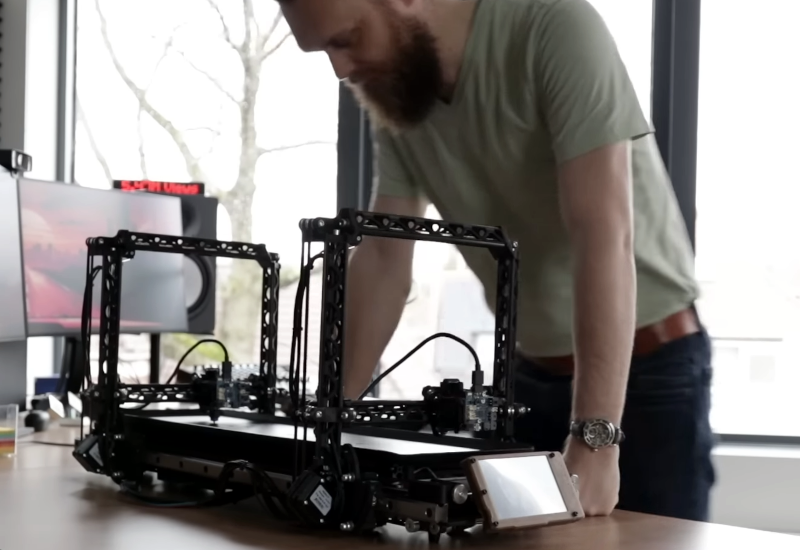If you look at [Proper Printing’s] latest video — see below — you’ll immediately get the idea behind his latest printer. There are two heads on two separate gantries, which, of course, opens up many possibilities. But when you think you’ve seen enough, you find out the heated bed is a kitchen griddle, and… well, for us, we had to keep watching.
The heated bed idea was interesting, although the flatness left something to be desired. While it is a simple idea, getting the two gantries to move reliably across the hotbed griddle took a lot of parts and a careful design. We wonder how evenly the griddle heats — ours definitely has hot spots when we cook with it.
While the video made it look smooth, he confessed that there were a few redesign cycles. We were curious about the electronics, and obviously, some of the more exotic uses for this will require customized software. The gantries use a core XY drive and it looks like there is still some work to do to perfect it.
We were also amused to see something we’ve seen a lot lately but would have never seen a decade ago. It is now so cheap to make a PCB that many projects, including this one, use PCBs with no traces to get precisely machined flat pieces made inexpensively.
There probably isn’t enough detail here to make an exact copy of the printer, but the real value here is the idea and if you have the interest, you can probably put your own spin on the system. Nothing seemed especially exotic.
If you learn nothing else, you’ll probably enjoy the field expedient filament holder that appears about 25 minutes into the video. Full disclosure: at the end of the video, he has only one gantry running, so clearly, this is a work in progress. But we do love unique printers. Especially those that have odd form factors.
















For an earlier version of a more polished (and expensive) multi gantry setup look into the machine Titan Robotics made for Autodesk’s “Project Escher”. Was back about 8 years ago.
Biggest issue from my understanding is firmware (setting up proper slowdowns to avoid collisions) and the slicer.
Personally, I would love to see more of the multi gantry concept being explored.
I made a large 3D printer at one point using an electric griddle. What I did was get a thin flat stone tile and heatsink epoxy that down onto the surface of the griddle using a slow cure heatsink epoxy so I had time to roughly level it (the fine leveling I did with screws and springs underneath).
I then used a solid state relay to let my RAMPS board drive the heated bed in bang-bang mode. I used a dremel to mill out a spot on the stone tile to heatsink epoxy in a thermistor and after a round of PID tuning and spot checking it at various points it was pretty even. The thermal mass of the stone made it very forgiving of the bang-bang drive although the downside was that it was slow to heat up.
This is where it might be useful to talk to a kitchen countertop place about purchasing a sink cutout or other large offcut from a slab they are cutting. Sometimes they will subdivide the offcuts to use as samples, but if you ask, they might keep it as a large offcut you can snag for cheap. Super flat already (some natural stone tiles are intentionally cut with a texture or cup to them), and not as heavy or thick as a precision granite slab used in machining work.
Bang bang and PID are two separate methods of heat regulation, you were doing one or the other.
The griddle is a reasonable idea, especially considering [Proper Printing] is using a sheet of glass as the actual print surface, a bit of gluestick and it’s good to go, even if it is a rough concept. He puts an absolute ton of work into these builds, it’s really a joy to watch someone iterate through ideas like he does.
Me too, Proper Printing is one of my favorite YouTube channels
what’s silly is that they can’t cross each other
I think the 2 gantries should have been mirrored on the Y axis, so both heads could reach a common central area. It’s a good idea and will likely require many more iterations to perfect.
The sad thing about this is that it’s not a hardware problem. That can be a little bit challenging too ofc but in essence if you do the software first, you will learn about any and all benefits. Then you do the hardware and learn about the downsides! (Probably the same as for every 3D printer, but squared since there is two of most parts!)